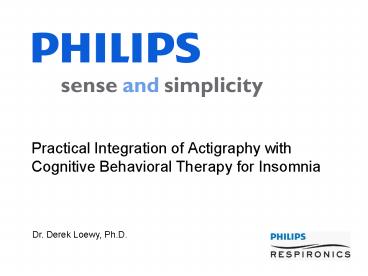Practical Integration of Actigraphy with Cognitive Behavioral Therapy for Insomnia - PowerPoint PPT Presentation
1 / 14
Title:
Practical Integration of Actigraphy with Cognitive Behavioral Therapy for Insomnia
Description:
Practical Integration of Actigraphy with Cognitive Behavioral Therapy for Insomnia Dr. Derek Loewy, Ph.D. Overview Background information Cognitive behavioral therapy ... – PowerPoint PPT presentation
Number of Views:158
Avg rating:3.0/5.0
Title: Practical Integration of Actigraphy with Cognitive Behavioral Therapy for Insomnia
1
Practical Integration of Actigraphy with
Cognitive Behavioral Therapy for Insomnia
Dr. Derek Loewy, Ph.D.
2
Overview
- Background information
- Cognitive behavioral therapy for insomnia (CBTI)
- Sleep diaries
- Actigraphy
- How actigraphy can enhance CBTI
- Sample actograms
- Program content overview
- Fitting actigraphy into the CBTI session
- Actigraphy/CBTI reimbursement update
3
CBTI Basics
- Clinically effective, behaviorally-based approach
to improve sleep for patients with
insomnia - Delivered individually or in groups
- Helps optimize the potential for good sleep,
improve sleep quality, and improve daytime
alertness through education and practice - Multi-component incorporates behavioral and
cognitive techniques delivered over weekly
sessions (typically four-eight) - Effectiveness of CBTI is highly dependent on
patient compliance
4
CBTI program from Philips Respironics
- Brief, four-session, CBTI program incorporating
conventional interventions - sleep hygiene
- sleep restriction
- stimulus control
- Integration of actigraphy as a central
therapeutic assessment tool
5
Sleep diary use in CBTI
- Useful and important component of the therapy
- Completed and tracked through therapy using paper
and pen - Patients perspective on sleep/wake pattern
- Informative for the patient and the therapist
regarding sleep perceptions - Input on progress, compliance, and therapeutic
adjustments - Limitations
- Entirely subjective
- Retrospective completion and recall errors
- Contradictory data
- Requires time-consuming, manual computation of
sleep/wake data
6
Actiwatch
Adds valuable quantitative and qualitative
elements to help compensate for sleep diary
limitations.
- Wrist-worn recording device
- Activity (accelerometer)
- Ambient light
- Event marking
- Designed to be worn 24/7
- Multiple-week recording time
Automated creation of a clinicians report with
objective information about the rest/activity
patterns to evaluate along with diary input and
self-report.
7
Using Actiwatch to enhance a CBTI program
- Statistics rapid, automated, computation of key
sleep variables (TST, WASO, SOL, sleep
efficiency, etc.) presented in concise tabular
format - Objective data that can be compared with diaries
- Weekly and change from baseline data
- Automation reduces time to make sleep scheduling
calculations - Data contradictions reduced when compared with
diaries
8
Using Actiwatch to enhance a CBTI program (Cont.)
- Actogram a continuous, longitudinal picture
of in vivo rest and activity behavior - Visual, qualitative depiction of sleep/wake
activity - Weekly feedback to the patient
- Therapist and patient can collectively identify
critical aspects of sleep/wake behavior
(circadian rhythmicity, sleep consolidation,
sleep schedule regularity, and napping)
9
Example actogram 1
Rhythmicity?
Consolidation?
Regularity?
Napping?
10
Example actogram 2
Rhythmicity?
Consolidation?
Regularity?
Napping?
11
Integrating Actiwatch into the CBTI program
- Preparation for program
- Provide to the patient at least one week
before Session 1 along with a sleep diary - Before each session
- Retrieve data (one-two minutes)
- Generate clinicians report and review data
(three-five minutes)
12
Integrating Actiwatch into the CBTI program
(Cont.)
- During each session
- Review previous weeks sleep diary and actigraphy
data - Patient feedback rhythmicity, consolidation,
regularity and napping - Compliance review adjust/troubleshoot as needed
- Review/modify sleep restriction plan
- Preparation for the next session
- Reconfigure (one-two minutes)
- Recharge (if needed during the session)
- Return device to the patient
13
Reimbursement
- Insurance coverage for actigraphy and CBTI are
variable - 95803 code for actigraphy
- EM codes for office visits, etc.
- Individual or group psychotherapy codes
- Health and behavior (HB) codes for assessment
and treatment - Roughly 30 of patients have coverage for CBTI
- Nationwide clarification of reimbursement rates
for actigraphy July 2009 - Out-of-pocket approach may be the most cost
effective - Group therapy will be appealing from a cost
perspective - 500-1200 for CBTI depending upon the number of
sessions and time
14
(No Transcript)































